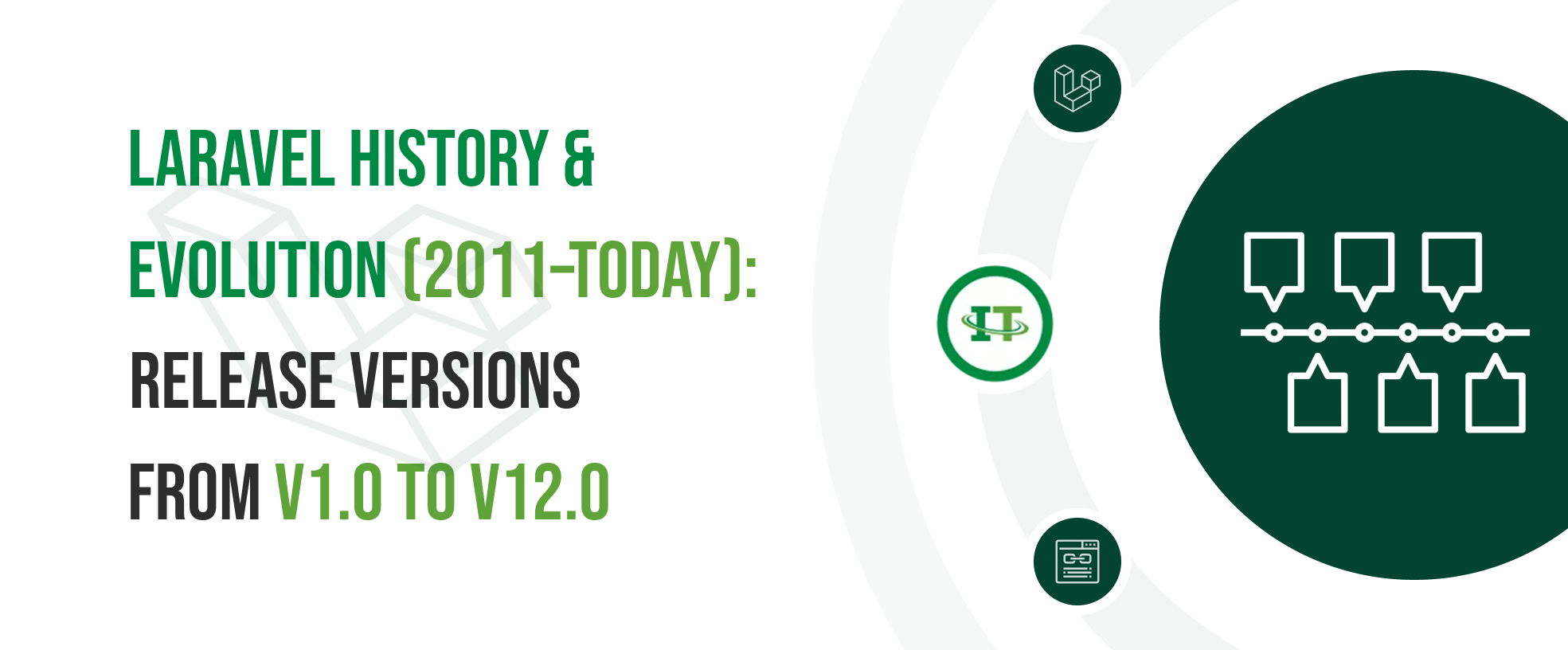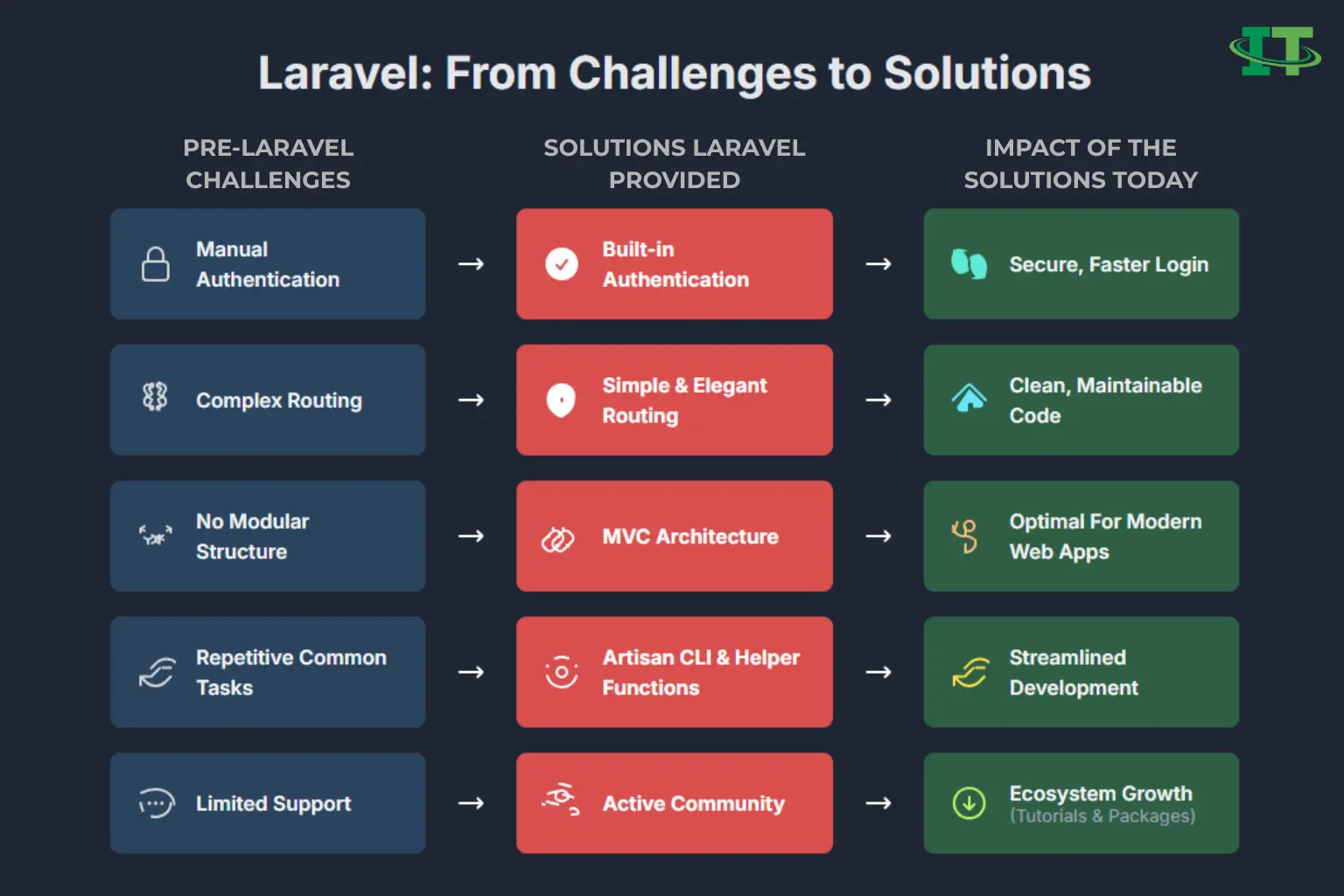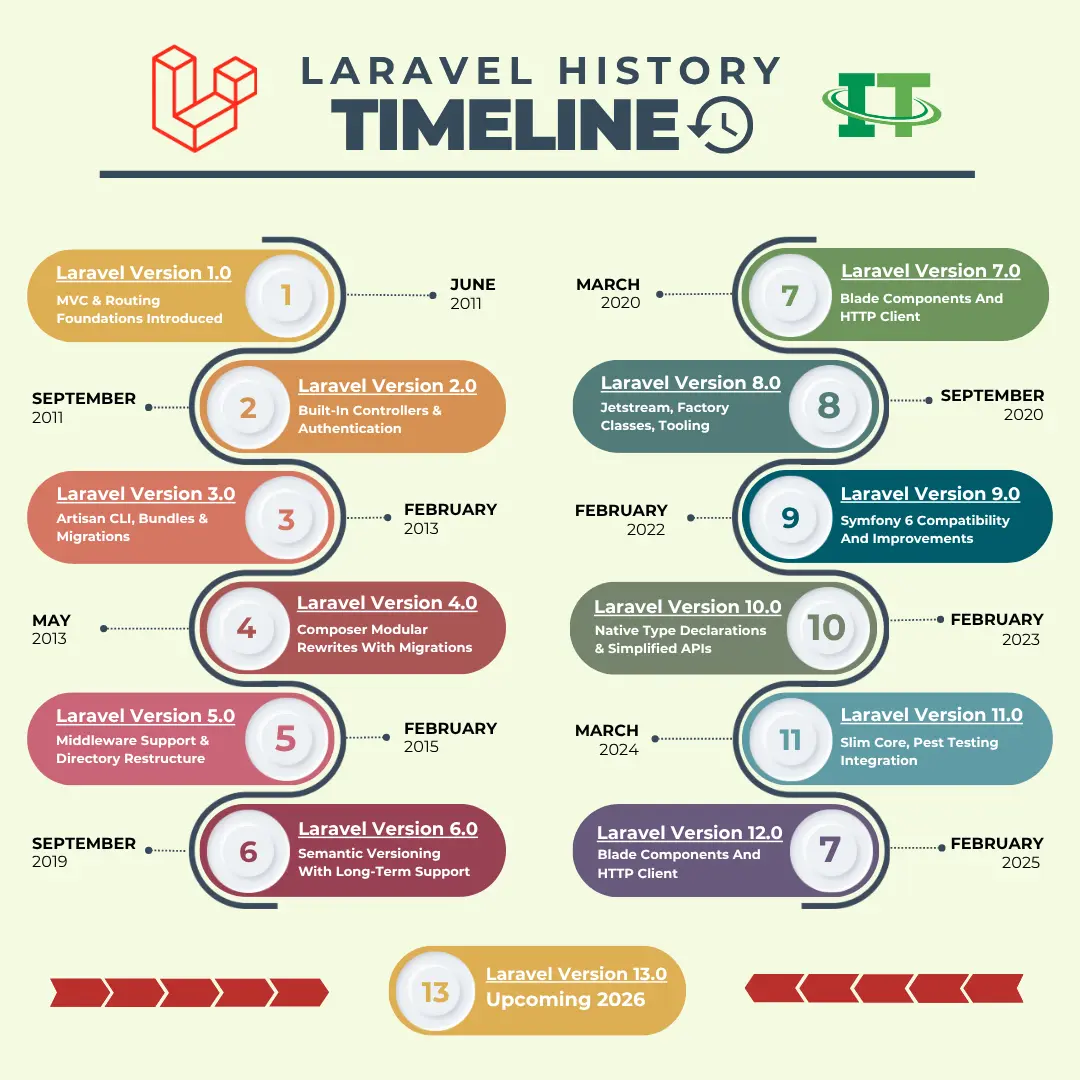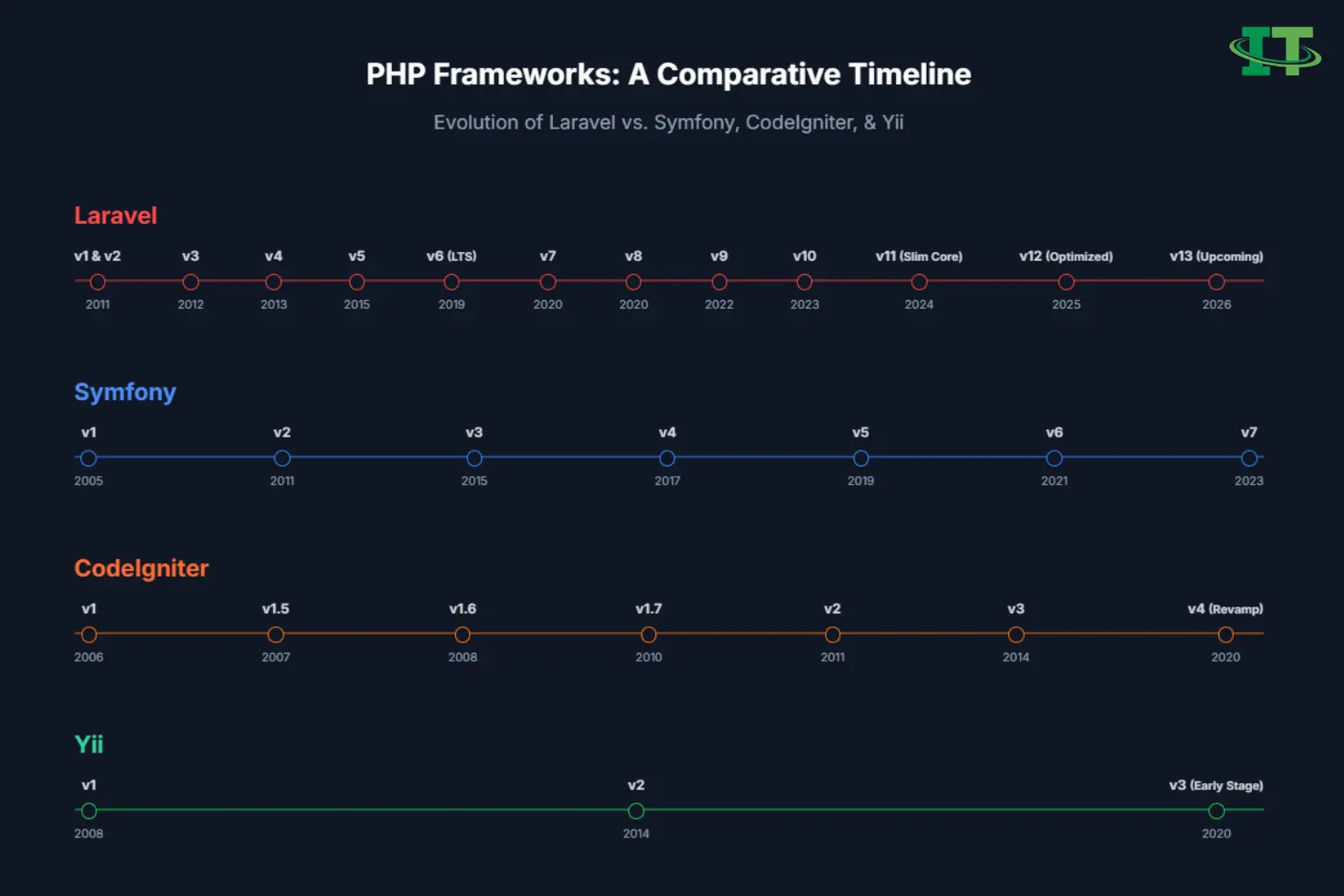History of Laravel Framework: Its Evolution From 2011 To Today!

Laravel, from a simple PHP framework tool to a revolutionary mechanism that empowers the modern web development world.
If you are a web app developer, you must be familiar with the potent tool Laravel. Interested to know about its evolution and pioneering journey? Let’s explore Laravel history, evolution, and booming performance in today’s tech trends.
What Will We Cover?
- The Origins of Laravel: A Developer’s Dream Takes Shape
- Laravel Release History: Demystified in Chronological Order
- Laravel 1.0 – June 2011
- Laravel 2.0 – September 2011
- Laravel 3.0 – February 2012
- Laravel 4.0 – May 2013
- Laravel 5.0 – February 2015
- Laravel 6.0 – September 2019
- Laravel 7.0 – March 2020
- Laravel 8.0 – September 2020
- Laravel 9.0 – February 2022
- Laravel 10.0 – February 2023
- Laravel 11.0 – March 2024
- Laravel 12.0 – February 2025
- Laravel 13.0 – Upcoming 2026
- Which Iconic Features Defined Laravel’s Evolution?
- Laravel vs. Other PHP Frameworks: A Historical Lense
- What’s Next? Peering Into The Future Trends of Laravel
Have you ever thought about how Laravel has become the heart of web app development? A simple PHP framework that emerged in 2011, is now empowering thousands of web apps, with its inevitable built-in features. Knowing the history of Laravel framework allows developers to make use of its effective features.
The lack of built-in features in CodeIgniter induced Taylor Otwell[1] to create Laravel in June 2011. The initial goal of Laravel was to ease developer’s work with effective functions like built-in authentication and modular packages. Laravel framework evolution from v1.0 to the current 12.0 version has constantly improved its performance and ensures incredible developer experience.
Remarkably, the MVC architecture in the Laravel releases captures the attention of a wide range of developers around the world. It supports beginner-level developers in building their apps and allows professionals to build complex applications.
Let’s go through the history of Laravel, interesting facts behind its evolution, and why Taylor Otwell created Laravel.
The Origins of Laravel: A Developer’s Dream Takes Shape
CodeIgniter’s limitations frustrated Taylor Otwell, inspiring him to create a framework with built-in authentication, routing, and developer-friendly tools. Let’s meet Taylor and his backstory, which ignited a spark in him to create Laravel.
Taylor Otwell’s Vision & His Story
You must be surprised to know the history of Laravel, this emerged from a simple idea during Taylor Otwell’s university days When he experimented with PHP, he often got frustrated by spending more time on repeating the same task. That experience sparked him to create built-in features for authentication and inspire developers creativity.
Taylor explored more of the PHP framework history and moved deeper into CodeIgniter, which made him find the clear gaps. The limitations of the existing framework envisioned a solution where Laravel’s initial open-source version 1.0 was released in June 2011.
Over time, many revolutions happened in Laravel’s features, for instance the Artisan CLI evolution that reflects Otwell’s futuristic thinking.
The June 2011 Launch: Laravel 1.0 Unveiled
Laravel 1.0 in June 2011 offered basic core features that provided a precise and customized approach to developers. The basic features laid the foundation for future Laravel version updates which includes routing and views optimized faster development, reduced manual efforts, simplified common tasks.
Inaugural Features:- Simple and clear routing
- Built-in authentication
- View templating
- Saves time from manual coding
- Elegant MVC architecture
- Clean and customized code practices
- Error handling
Basic Laravel 1.0 Route Example:
Route::get('/', function() {
return 'Hello, Laravel!';
});
In CodeIgniter or other plain PHP, every time you’d have to add if/else code inindex.phpif you wanted to create a new page. But with Laravel 1.0 you had routes with closures so that you could define routes separately and cleanly, instead of editing in index.php.

Let’s explore its release history from 2011 to the future releases.
Laravel Release History: Demystified in Chronological Order
More than excitement, understanding the Laravel release history provides a roadmap to your innovation in the next project. Developers can build apps with creative innovation with every update and new Laravel release.

Foundational Years: Laravel 1–5 (2011–2015)
Do you remember the foundational years of Laravel? It’s between the years 2011 and 2015, the Laravel framework evolution from v1 to v5. The implementation of Composer in and migrations in v4 have set standards for modern applications in the Laravel development timeline.
Laravel 1.0 – June 2011
The initial version, Laravel 1.0laid the foundation for the Laravel framework evolution. It offers developers a simple and customized approach to PHP web development.
Features:- Basic routing
- Simple view templating
- Basic authentication
- Error handling
- Lightweight architecture
Laravel 2.0 – September 2011
In September 2011, the next version Laravel 2.0 was released. It came up with improved structure and functionality from Laravel 1.0 The second version offered controllers that can organize code.
Features:- Controllers to organize code
- Better routing
- Enhanced error handling
- Multiple database support
Laravel 3.0 – February 2012
Want to know when the package management got better? It got a lot better with Laravel 3.0 arriving in February 2012, to make development faster and expand the core functionality.
Features:- Bundles for package management
- Artisan CLI (command Line Integration)
- Migration support
Laravel 4.0 – May 2013
The next release, Laravel 4.0 launched in May 2013, arrived with more focus on improving modularity, and providing friendly developer experience. It revolutionized the framework with full Composer integration, aligning Laravel with modern PHP standards.
Features:- Eloquent ORM overhaul
- Full integration with Composer
- Improved MVC structure & Service Containers
- Enhanced routing and RESTful controllers
Laravel 5.0 – February 2015
The goal of the next Laravel release, launched in February 2015, Laravel 5.0 was to improve developers’ productivity to build customized modern web applications.
Features:- Middleware support
- Task scheduling
- Authentication Scaffolding
- Directory restructuring
Modern Era Boom: Laravel 6–9 (2019–2022)
In the modern era of boom from 2019 to 2022, the Laravel versions from 6 to 9 set a vibrant PHP ecosystem. It became the powerhouse of PHP development with semantic versioning.
Laravel 6.0 – September 2019
Launched in September 2019, Laravel 6.0 enhanced a noticeable shift to semantic versioning, and project stability. It remarkably supports the Laravel community growth, thus actively engaging the developers.
Features:- Semantic versioning
- Enhanced authorization responses
- Laravel UI
- Lazy collections
- Job middleware
Laravel 7.0 – March 2020
Focusing on developers’ productivity, Laravel 7.0 released in March 2020 with cleaner code. Thus, Laravel version updates strengthened scalability and blade component syntax and rendering.
Features:- Better blade component
- Custom eloquent casts (cast classes)
- Route caching
- HTTP client
Laravel 8.0 – September 2020
The update in Laravel 8.0 in September 2020 focusing on flexible database seeding and testing. Thus, the redesigned model provides a user-friendly experience and increased productivity of developers.
Features:- Job batching
- Improved rate limiting with RateLimiter class
- Dynamic blade components
- Laravel Jetstream (new app scaffolding)
- Model factory classes
- Improved php artisan serve with auto-reload
Laravel 9.0 – February 2022
Do you know which laid the foundation for Laravel’s robust performance? The release of Laravel 9.0 ignited the spark by embracing compatibility with modern PHP features. LTS (long-term support) allows developers to handle enterprise-grade projects.
Features:- Anonymous stub migrations
- Enhanced Eloquent accessors and mutators
- Symfony mailer integration
- Query builder interface
- Full PHP 8 support (attributes, etc.)
- Controller route groups
- Flysystem 3 integration
Next-Gen Evolution: Laravel 10+ (2023–Now)
The features introduced in Laravel 6 to 9 initiated more stability, which was continued by later versions i.e Laravel 10+This next-gen evolution significantly improved the features in the Laravel version updates. Beginners and experienced developers gain more power and flexibility through the release of Laravel 10 to the upcoming Laravel 13.
Laravel 10.0 – February 2023
The features in Laravel 10.0 in February 2023 made future releases conform to modern PHP practices. The significant updates mentioned below have a remarkable note in the Laravel version updates timeline.
Features:- Native type declarations
- Laravel Pennant for feature flags management
- Process facade for handling external tests
- Invokable validation rules
Laravel 11.0 – March 2024
Have you ever thought about what makes Laravel a lightweight framework? Here comes Laravel 11.0 in March 2024 with developer experience updates. Laravel 11 updates removed older support code, simplified the app skeleton, and reduced boilerplate to stay lightweight.
Features:- Reduced application skeleton
- Broadcasting setup
- Encryption key rotation support
- Built-in health routing
- Per-second rate limiting
- Artisan improvements
A Quick v11 Health Check – Essential For Production:
use Illuminate\Support\Facades\Route;
// Health check route
Route::get('/up', function () {
return response()->json(['status' => 'ok']);
});
Before the launch of Laravel v11 the developers had to manually write scripts to monitor uptime. Laravel 11 offers a quick way to check in live apps. The /up route enhances a simple health check. If the response is “ok“, the app is running healthy. It immensely supports production monitoring, load balancers, or CI/CD pipelines, and uptime verification.
Laravel 12.0 – February 2025
The current version is Laravel 12.0, launched in February 2025, which enhances robust performance and modern development workflows. The adoption of front-end tools enables developer utilities and enhanced productivity.
Features- New starter kits supporting React, Vue, and Livewire
- Streamlined WorkOS AuthKit integration
- HasUuids trait now defaults to UUIDv7
- Performance optimizations via xxHash
Laravel 13.0 – Upcoming 2026
Developers can expect the next version of Laravel 13.0 in the beginning of 2026. We can expect it to have a next-gen performance, be a significant modernizing tool, and reduce legacy compatibility layers. Laravel 13 is expected to require PHP 8.3+ to enhance a significant modern web app development.
Here’s a compiled table for quick go-through:
| Version | Release date | Key Features | Backward Compatibility Notes |
|---|---|---|---|
| 1.0 | June 2011 | Basic routing, view templating, simple authentication | No controllers, limited MVC |
| 2.0 | September 2011 | Controllers, better routing, error handling, and database support | Fully MVC, minor adjustments needed |
| 3.0 | February 2012 | Bundles, Artisan CLI, migrations | Improved modularity, mostly compatible |
| 4.0 | May 2013 | Composer integration, Complete rewrite, improved MVC | Significant changes require code updates |
| 5.0 | February 2015 | Middleware, enhanced Artisan, task scheduling | Some structural changes, mostly compatible |
| 6.0 | September 2019 | Semantic versioning, LTS, better debugging | LTS ensures long-term support |
| 7.0 | March 2020 | Blade components, custom Eloquent casts, HTTP client | Mostly compatible |
| 8.0 | September 2020 | Job batching, dynamic Blade, rate limiting | Compatible with minor adjustments |
| 9.0 | February 2022 | Eloquent accessor/mutator improvements, Symfony Mailer | Mostly compatible |
| 10.0 | February 2023 | Pennant, native type declarations, invokable validation rules | Compatible |
| 11.0 | March 2024 | Health routes, slimmed app skeleton, simplified queue & broadcast | Compatible |
| 12.0 | February 2025 | Starter kits (React/Vue/Livewire), improved Artisan | Compatible |
Are you still confused about what makes the Laravel framework a legend? Let’s explore the iconic features.
Which Iconic Features Defined Laravel’s Evolution?
Laravel launched with simple features; yet, if we look into the Laravel history, it has become a powerhouse for developers. The Eloquent ORM and Artisan CLI updates make the web development process simple and provide a user-friendly experience. Let’s go through the history of Laravel and its iconic features.
From Basic Tools to Powerhouses: Eloquent and Artisan
The Eloquent ORM & Artisan CLI were introduced in Laravel 1.0,replaced SQL and enabled developers to interact with databases. This became an iconic leap in Laravel framework evolution, as Laravel 11.0 arrived with app structure simplification, health checks, and Reverb. With Artisan CLI released in Laravel 3.0, it enabled developers to automate everything from migrations to queue jobs.
Templating and Authentication Milestones
Earlier, templating and authentication were minimal and basic, with the regular updates, Laravel empowers developers with clarity and security. Templating and authentication, together, shaped a developer experience that remains powerful in modern web development.
Key Evolutions:| Feature | Introduced in | Key Update | Key evolution | Current Use Case |
|---|---|---|---|---|
| Eloquent ORM | v1 | Relationships, eager loading | Supports efficient development | Database interaction, relational mapping |
| Authentication | v2 | Starter kits | Basic authentication | Secure login, user management |
| Blade templating | v3 | Components, directives | Major UI templating upgrade | Reusable, dynamic UI templates |
| Artisan CLI | v3 | Process handling, improved commands | Supports efficient development | Automating dev tasks, migrations |
| Middleware | v5 | Better rate limiting | Authentication scaffolding with middleware | Request filtering, authentication, and throttling |
| Model factories | v8 | Job batching, Migration squashing | Simplified testing and seeding the database | Test data generation, database seeding |
| Frontend integration | v11 | React, Vue, and Livewire | Dynamic front-end experiences | Interactive, modern UI development |
Are you still wondering how Laravel versions take the crown over other PHP frameworks? Let’s break the secret.
Laravel vs. Other PHP Frameworks: A Historical Lens
Laravel is not alone in the web development world; we have Symfony, CakePHP, Yii, etc. But Laravel becomes developers’ favourite with its elegant syntax and built-in tools, causing faster adoption. This, in turn, develops Laravel community growth and encourages developers to explore it.

Early Rivalries And Laravel’s Edge
CodeIgniter was the prominent PHP tool until 2011, but it lacked built-in authentication and modular packages. Laravel’s later versions arrived with a structured MVC approach in the early stages, creating a remarkable moment in Laravel history.
Another promising tool is Symfony, it has robust features but is difficult to understand for effective results. Whereas Laravel’s elegant syntax and Artisan CLI evolution supports developers to get effective results with less code.
Mid-Decade Shifts
We can find out major updates in the Laravel history during 2015 and it caused notable impact on the PHP ecosystem. It supports the developer world widely with its advanced packages and tutorials.
Market Share Wins:- Increased adoption
- Frequent Laravel releases
- V5 offered middleware and task scheduling
- Active community growth, forums, and GitHub contributions.
- Developer choice for modern MVC architecture.
Let’s look into the quick comparison of Laravel with other frameworks.
| Framework | Launch Year | Strength in the 2010s | Laravel’s Counter-Feature |
|---|---|---|---|
| CodeIgniter | 2006 | Lightweight, simple | MVC, authentication, modular packages |
| Symfony | 2005 | Reusable components, high performance, enterprise scalability | Artisan CLI and elegant syntax |
| CakePHP | 2005 | Fast scaffolding | Eloquent ORM, migrations, and Blade templating |
| Zend Framework | 2006 | Enterprise-grade, component-based | Community-driven packages, simple structure, and modern PHP practices |
If you want to explore future Laravel version updates, then let us explain its upcoming trends.
What’s Next? Peering Into The Future Trends of Laravel
Laravel history is inspiring, but the real excitement is ahead. The future is in the hands of AI; Laravel is not an exception. The Laravel roadmap hints at AI integrations that provide a smarter workflow. The refined Laravel 11 updates ensure the productivity of PHP developers.
Predicted Milestones for Laravel 13+
Laravel 12.0 laid the foundation for Laravel 13+, it promises to take up PHP development. The Laravel roadmap leading the future Laravel release with bold innovations, with streamlined developer workflows.
Future trends:- AI integration
- Serverless support
- Enhanced developer tooling
- Seamless frontend integration
Summing It All Up
We explored the Laravel history and Laravel version updates from scratch to the future trends. Though it arrived during Taylor Otwell’s university days today it has become the heart for developers in web development. Laravel versions have gone through robust updates and features that have made it a go-to choice for every developer.
The PHP framework history enables developers to leverage the framework more productively in real-world projects. With active Laravel community growth, everyone who is eager to learn Laravel will kick-start their learning. Today, let’s dive into v11 and leverage your development workflow with robust built-in tools.
Give a glimpse for a quick recap.
TLDR – Key Takeaways:
- Laravel was created in June 2011
- Laravel has evolved from v1 to v12
- Eloquent ORM and Artisan commands become a game-changer
- Robust MVC architecture simplifies complex code
- Semantic versioning in v6 ensures long-term stability
- Laravel community growth enhances a developer-friendly approach
- AI integration – future Laravel releases v13+
Frequently Asked Questions (FAQs)
We’ve gone through Laravel history from scratch to the future trends. Still you have common queries? Let’s break down.
1. What is the history of the Laravel framework?
Laravel is a modern PHP framework created by Taylor Otwell in June 2011 with basic routing, views and authentication. With frequent updates and releases, it evolved to a robust tool which includes Eloquent ORM, Artisan CLI and blade templating and becoming a leading PHP framework today.
2. Who developed Laravel?
Laravel was developed by Taylor Otwell in June 2011 which replaced other PHP frameworks with its efficient features. He was inspired to create Laravel during his university days.
3. How old is the Laravel framework?
Laravel is just 14 years old now (2025). Laravel releases have undergone significant updates over the years and serve developers worldwide tremendously.
4. What is the latest version of Laravel?
With immense features, Laravel 12.0 is the latest version which was released in February 2025. The starter kits like React, Vue, and Livewire, integrated TypeScript, and Tailwind CSS 4.0 increases developers’ productivity in building robust applications.
5. Why is Laravel the best choice since 2011?
From day one, Laravel has been sparkling out among other PHP frameworks with its developer friendly features. The presence of powerful built-in tools, Artisan CLI, Eloquent ORM and elegant syntax captures developers attention. With active community support, it becomes a favourite for both beginners and experienced professionals.
Let’s Turn Your Innovation Into Reality With iCommuneTech!
We offer developers and businesses of all scales high-performance Laravel applications to enhance their functions. Our solutions will save your time and greatly increase productivity.
Let’s build your web applications. Contact us for further details!
References
1. Taylor Otwell – (LinkedIn Profile)
Irshad Pathan

Web Development Expert
Irshad is a senior technical expert at iCommuneTech. He manages the iCommuneTech's Web Development Team, and has hands-on expertise in web development, Laravel development, Logistics, fleet management, and Supply Chain Management. He mentors the in-house team and enjoys describing his experience in words.
